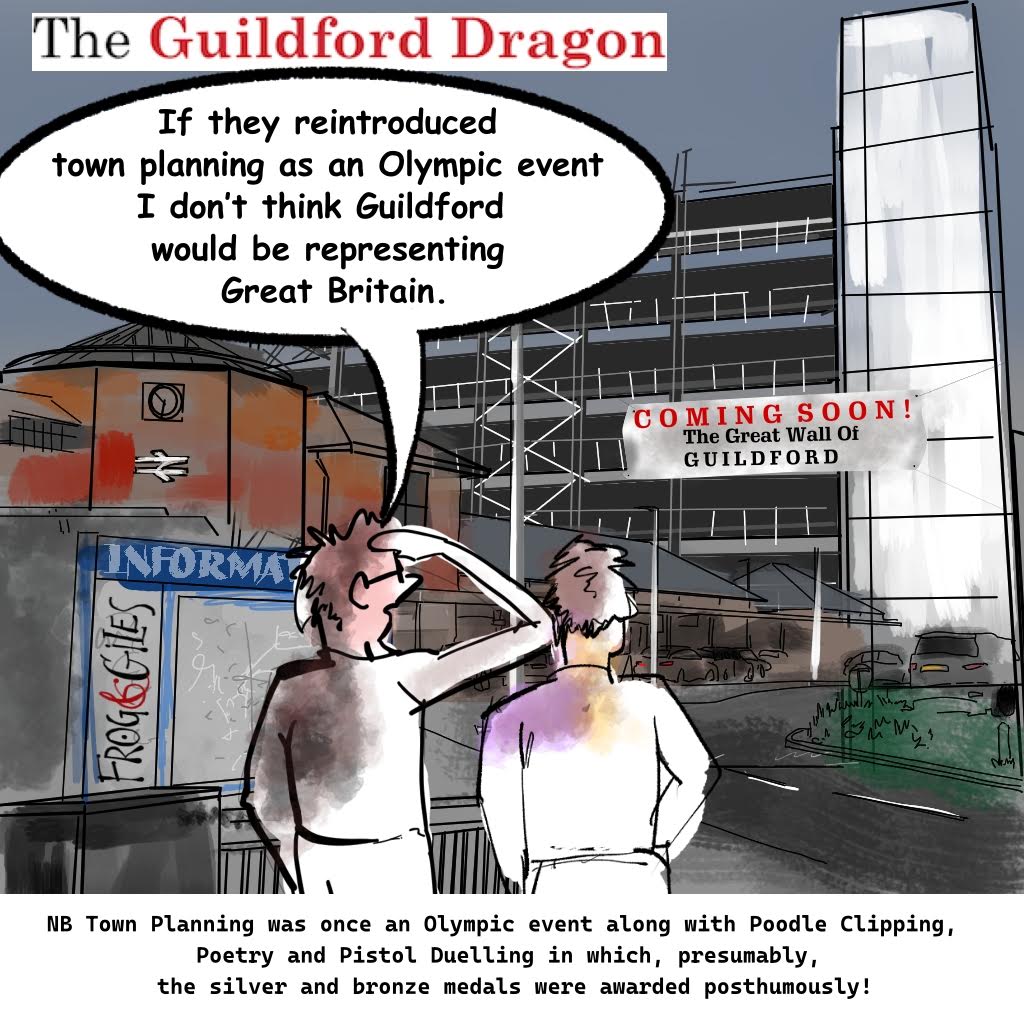 Abraham Lincoln
If given the truth, the people can be depended upon to meet any national crisis...
Abraham Lincoln
If given the truth, the people can be depended upon to meet any national crisis...
 Guildford news...
for Guildford people, brought to you by Guildford reporters - Guildford's own news service
Guildford news...
for Guildford people, brought to you by Guildford reporters - Guildford's own news service
Letter: Upstream Reservoirs and Gyratory Removal Are Essential for Shaping Guildford’s Future
Published on: 19 Jul, 2024
Updated on: 19 Jul, 2024
In response to: GBC Should Not Ignore ‘Shaping Guildford’s Future’
I fail to understand what John Rigg means by: “The flood alleviation scheme (FAS) does not and would not seek to resolve flooding up or downstream of Guildford.” Measures upstream would be necessary to control floodwater arriving at Guildford town centre. If not, flooding has to be contained within walls.
The proposals show walls along the west of the river (where the ground is generally at a higher level) but on the east it would be allowed to inundate the shore up to a wall further away from the river. What is the point then of losing valuable land other than to create a “pleasant” riverside that although desirable would be very expensive? The riverbank would have to be cleaned every time after flooding takes place.
“However, the Environment Agency requires any scheme not to worsen the situation up or downstream, which is logical and accepted,” says John Rigg. What does worsening the situation mean? Upstream flood plains could be lowered to increase their capacities to hold floodwater but the EA is not proposing to do that.
The Shaping Guildford’s Future papers show Woodbridge Meadows development that would require a wall containing floodwater from inundating Walnut Tree Close. I have not come across any proposal to deal with flood plains south of Clay Lane. Relocation of Thames Water Sewage Treatment Plant and the development of Slyfield Weyside Village would also require protection from flooding.
“The road investigations in the plan identified options only and commits to none.” – an “option” has to be a working solution of some sort. It is not an “option” if it does not resolve the problem. So quoting John Rigg again: “the investigation acknowledges, as you would expect, the impossible task of squeezing a quart into a pint pot,” is exactly the issue.
There is inconsistency between the video and the sketch for Town Bridge. The video shows the existing Town Bridge whereas the sketch shows a new realigned bridge both one lane only each way. The Y-Option and the C-Option for traffic movements replacing the gyratory are both unworkable due to sheer volume of traffic.
In the C-Option, traffic from Farnham Road and the railway station would have to cross the river three times to go to Millbrook! From Portsmouth Road if a right turn towards Town Bridge is not allowed, (most likely to keep the traffic phases to a minimum) traffic wanting to go to Millbrook would also have to cross the river three times.
“But a reality check means we know GBC and SCC have no funds for tunnels and major road building, and central government resists road building where they believe it will facilitate and encourage more traffic,” a popular but unrealistic approach to dealing with increasing traffic. I remember it well when it used to take three to four hours of driving from Guildford to Dover before the M25 and the M20 were built. Following this line of argument the UK should not have built any of the motorway network at all.
Should a new east-west route over the river and the railway in Guildford have taken precedence over Ash Bridge costing £45 million and Walnut Footbridge costing £5 million? I think so. There is funding available after the HS2 curtailment for building roads to relieve congestion. Guildford is a prime example where improvements to road network is necessary to deal with the congestion and facilitate provision of dedicated cycle lanes and better pedestrian environment in the town centre and its riverside areas by removing the gyratory and making Friary Bridge for pedestrians only.
“We need to build on the work carried out rather than the easier approach of kicking difficult projects into the long grass and quietly writing off the cost, ” says John Rigg. But for example, judging by the number of reports prepared by consultants for possible relocation of the bus station, ultimately nothing has changed.
The bus station is staying where it is and North Street development would be adding to the congestion on Leapale Road and Onslow Street. The idea of creating a transport hub has been lost forever together with better cycle lane provisions in the area. I have illustrated the possibilities on my keepandshare websites.
An active flood control with upstream reservoirs and improving the road network by removing the gyratory are both essential for shaping Guildford’s future. I rest my case.
Responses to Letter: Upstream Reservoirs and Gyratory Removal Are Essential for Shaping Guildford’s Future
Leave a Comment Cancel replyPlease see our comments policy. All comments are moderated and may take time to appear.
Recent Articles
- Rollout of Guildford’s e-Bike Scheme to Commence
- Notice: Help Save Our Environment at Zero
- Guildford’s Book Festival Is Only a Month Away
- New McDonalds Proposed for Cobham is ‘Last Thing Surrey Needs’ say Objectors
- Letter: A New East-West Crossing is Essential for Guildford
- Two Jailed After Hotel Asylum Protest Leads to Violent Outbursts
- Developers Submit New Plan for Housing at Ash Green’s Ancient Manor House
- Birdwatcher’s Diary No.311
- Latest Solum Proposal Is for Redhill Station
- Surrey Councils Urge Residents To Reduce Food Waste


Recent Comments
- Jules Cranwell on Developers Submit New Plan for Housing at Ash Green’s Ancient Manor House
- Olly Azad on Latest Solum Proposal Is for Redhill Station
- Mary Hickman on Latest Solum Proposal Is for Redhill Station
- Jim Allen on Letter: Shouldn’t Taxes Benefit the UK Population?
- John Perkins on Letter: Shouldn’t Taxes Benefit the UK Population?
- Michael Duff on Birdwatcher’s Diary No.311
Search in Site
Media Gallery
Dragon Interview: Local Artist Leaves Her Mark At One of England’s Most Historic Buildings
January 21, 2023 / No Comment / Read MoreDragon Interview: Lib Dem Planning Chair: ‘Current Policy Doesn’t Work for Local People’
January 19, 2023 / No Comment / Read MoreA3 Tunnel in Guildford ‘Necessary’ for New Homes, Says Guildford’s MP
January 10, 2023 / No Comment / Read More‘Madness’ for London Road Scheme to Go Ahead Against ‘Huge Opposition’, Says SCC Leader
January 6, 2023 / No Comment / Read MoreCouncillor’s Son Starts Campaign for More Consultation on North Street Plan
December 30, 2022 / No Comment / Read MoreCounty Council Climbs Down Over London Road Works – Further ‘Engagement’ Period Announced
December 14, 2022 / No Comment / Read MoreDragon Interview: GBC Reaction to the Government’s Expected Decision to Relax Housing Targets
December 7, 2022 / No Comment / Read MoreHow Can Our Town Centre Businesses Recover? Watch the Shop Front Debate
May 18, 2020 / No Comment / Read More













David Ogilvie
July 20, 2024 at 12:39 pm
Bibhas Neogi is spot on. He talks sense and I agree with him.
Bibhas Neogi
July 21, 2024 at 2:30 pm
Thank you David Ogilvie for your affirmation.
Guildford’s future shouldn’t be allowed to drown in a spate of half-hearted measures.
Guildford would then glisten in glory and not remain dull. We must all flood the councils with our ideas and encouragement.
John Rigg
July 21, 2024 at 2:46 pm
I agree with Bibhas Neogi, perfection is a better way forward when available. I have agreed with David Ogilvie a new cross-Guildford road and either of their proposed tunnels would be wonderful. Providing upstream storage costing millions more would be a superior flooding solution and solving downstream flooding would also be a good thing.
However perfection is rarely available. Also the decision is not mine. I do know pragmatism might be required if anything at all is to happen. So far nothing has happened.
Unlike architects, my career in property investment and development funding was invariably tackling how to fund projects, how to make them viable with the funds available.
When acting as a councillor fundraising issues with or without available grant had to be considered. I am afraid I would prefer to spend my time working on the art of the achievable.
Others are free to press their own case for their own solutions. Mine are based on what the “Shaping Guildfords Future” team of Ove Arup, Gleeds and other consultants advised when working with the Environment Agency to establish a deliverable solution. This means one the EA would feel comfortable to support, an essential prerequisite for grant funding.
John Rigg is a former R4GV borough councillor.
Ben Paton
July 23, 2024 at 7:05 pm
John Rigg belongs to the Paula Vennells School of Management ie he knows best what everyone should do and think and if they dare think differently they deserve not reasons and evidence but the acid of his sarcasm.
John Lomas
July 23, 2024 at 8:32 pm
Are the water meadows between Shalford and Guildford, which used to be flooded during the winter for ice skating, suitable for a water holdback facility also what about the area between the navigation and the river’s course to the E of St Catherine’s lock?